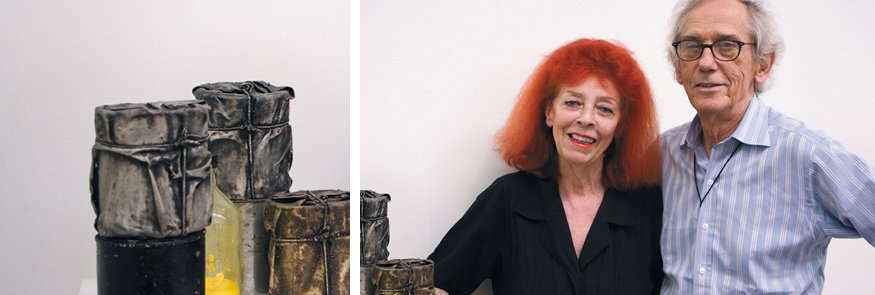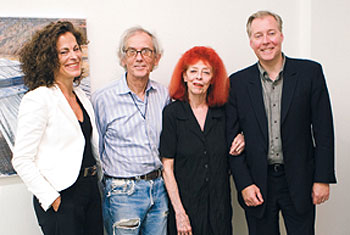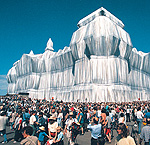Interview with artists Christo and Jeanne-Claude †
“The never-to-happen-again dimension is something people can connect with.”

Whether it’s wrapping the Reichstag or installing the Gates in New York’s Central Park, every one of Christo and Jeanne-Claude’s works of art is utterly unique, and the pair have carved out their own distinctive niche in the art world through their work. In this interview with THE FOCUS they talk about the determination and passion they bring to their projects – battling against resistance, even if the process lasts for decades.
The Focus: Your work often involves years of preparation for an installation that transforms a site for just a few days. Why do you do this?
Christo: We are artists; we do things for no particular reason – no particular purpose. It’s like painting on a white canvas – you cover it with paint; there is no reason to explain why you want to cover it with paint, or why you use blue and yellow or other colors.
Jeanne-Claude: But for us there is a reason and it’s always the same one: We want to create a work of art, of joy and beauty.
The Focus: Wouldn’t there be more joy and beauty if the work lasted longer than just the two weeks you gave the Wrapped Reichstag in Berlin or the 7503 Gates in New York’s Central Park?
Jeanne-Claude: That is an aesthetic decision. Limiting the duration is a way of endowing our work with those feelings of love and tenderness for things that do not last – like childhood or like our own lives.
Christo: Human beings like to experience something absolutely irrational. Our projects link to that freedom because nobody can buy them. Nobody can own The Gates; nobody can sell tickets for them or have any other claims on them. We even rented the site, which ran us into a lot of legal trouble but basically made this project unique for fourteen days. And this never-to-happen-again dimension is something people can connect with. They know The Gates won’t last forever.
The Focus: So the transitory character of your projects enhances their uniqueness?
Christo: All our projects are unique. We never do anything twice. We don’t work like architects or sculptors. Each project is a totally new image, never done before. Which makes it difficult to get permission. If you are familiar with the process of obtaining permits anywhere in the world, you’ll know that all bureaucrats look for precedents. If you are an architect and you want to build a bridge, they consult their records to see what happened the last time someone built one. But for our projects there are no precedents, there are no existing records.
The Focus: You are also unique in having developed a business model for financing your projects – whose costs often run into millions.
Jeanne-Claude: The only way to work in total freedom is to pay for it. When you accept outside money, someone wants to tell you what to do. So we fund each of our projects with our own money – through sales of Christo’s preparatory drawings, collages and early works. But we never know if they will sell fast enough to meet the expenses.
Christo: That’s why we work with banks, and with banks only, because art collectors and museums are notoriously slow payers.
Jeanne-Claude: And in order to do this in 1969 we founded CVJ, the Christo Vladimirov Javacheff Corporation. It has a President and Treasurer – myself – a Vice President, and a Secretary. And then there is the Assistant Secretary, Christo Javacheff.
The Focus: Do you see a link between this wish for freedom and your childhood under a communist regime?
Christo: My Marxist education clearly helped me in using the resources of capitalism for my own ends. On the other hand it made me averse to any kind of message. Messages can be political, religious, commercial – they are all propaganda. I will never do art with messages. Our projects are much more complex, much more meaningful than any illustrative art.
Jeanne-Claude: But the reason for founding the corporation was mainly practical. For us it is very important to have a cash flow. We can pay for the early engineering studies for our projects because those bills come in sporadically. But when we start to hire workers to install the project, we have to meet the payroll every Friday. We can’t count on art sales to come in on time.
Christo: This is why we are the biggest owner of our work. We keep it in our storehouses, the main one being in Basel, Switzerland, where we have our own curator. When CVJ Corporation negotiates a credit line with a bank, these works of art serve as collateral. So they enable us to pay for our projects.
The Focus: Many artists accumulate a lot of money. But you are the first ones to found a corporation.
Jeanne-Claude: If others want to accumulate money, that’s fine with us. Our aim is different and very specific: We only want to build art. For us, money is like manure. It is good only if you spread it around; only if it helps you do what you want to do.
Christo: And we try to keep it that way. Even if it means that we have to be our own gallery, our own art dealer.
Jeanne-Claude: Christo not only frames his drawings himself, but we also sell the works and sometimes buy them back – either because we regret having sold them cheaply in the first place, or because it’s a bargain. There’s also a concern if the price goes too high – we don’t want a flood of Christos on the secondary market because it will affect the prices on the primary market.
The Focus: Do you see this preparatory work as part of your work of art?
Christo: All our projects have two distinct periods, the “software” period and the “hardware” period.
Jeanne-Claude: The software period is when the work exists only in the mind.
Christo: Physically, it doesn’t exist except for a growing pile of drawings. This is the stage when we fight to get permission – often the most difficult part of our project. But we particularly like this software period because it generates a tremendous energy, an energy that’s unimaginable from the outside.
“We particularly like the software period – it generates a tremendous energy, an energy that’s unimaginable from the outside.”
The Focus: The Focus: Would you say the greater the challenge, the greater the pleasure?
Jeanne-Claude: No. The software process is part of the work of art in the same way that a woman’s pregnancy is part of having a child. But the pregnancy is not the aim. The aim is having your baby. Now some pregnancies go very well, and with some pregnancies you vomit for the first two months. None of that makes any difference in the end, when you see the baby.
Christo: We’re not masochists. All these projects start with a kind of unconscious challenge and then develop in unforeseen ways. When we started Over the River in 1992 there was a simplicity about the idea. We didn’t know we would have to drive more than 15,000 miles through the Rocky Mountains and inspect 89 rivers to find the perfect site. We didn’t know we would need legal documents and papers by specialist lawyers, which now make up a 2029-page book. And we didn’t know we would have to spend six million dollars. We would have preferred to spend much less.
The Focus: How do you begin your projects – with the concept or with the site?
Christo: There are two different types of approach. There are rural projects like the Running Fence or the Umbrellas, where you have a concept and look for a site. Whereas the Reichstag was an urban city project; we had a site which inspired us with an idea.
Jeanne-Claude: In this regard Over the River is peculiar. Its roots go back to Paris. When we were wrapping Pont Neuf in 1985, Christo and I were standing on a barge directing the climbers who were placing the fabric on the underside of the arches. And in the middle of all this noise and activity, we looked up at the fabric and it was so beautiful, silvery and shimmering in the reflected light of the river, and we smiled at each other. It took us seven years to figure out what that smile meant, but that was the start of Over the River.
The Focus: With more than six million dollars already spent, this is an ambitious project…
Christo: The idea is to suspend fabric panels horizontally above the water level of a river. They will be attached to steel wire cables, anchored on the upper part of the river banks and crossing the river. The panels will follow the configuration and width of the changing course of the river, for a total of 5.9 miles – not counting interruptions by bridges, rocks, trees, and bushes. This is obviously the type of project where you begin with an idea and look for a location. We ended up with six possible sites for Over the River.
Jeanne-Claude: All of which were rafting rivers, which is important because the panels should be seen from the water as well as from the land. In the end we chose the Arkansas River, the most rafted river in the United States. A 42-mile stretch of this river proved to be the most suitable for our project.
The Focus: How can you be sure that a structure of this kind will be safe?
Christo: In 1996 our engineers decided they needed more information. We hired the services of one of the world’s leading engineering companies, but we weren’t satisfied with the results. So we found a ranch in Grand Junction, in the western corner of Colorado, far away from the Arkansas River. And here, in 1997-99, we carried out four full-scale tests.
Jeanne-Claude: These tests were important not only for our engineers but also for us because we had to choose the color of the fabrics. Some contain more silver, others have more copper, and the sewing is different, too. There are so many decisions to take, and it was only after the four life-size tests that we were able to make our choice. But all of that is done now and the project is ready to be realized in any given summer, although not before 2012.
The Focus: The Focus: Your creative process involves financing, project management, obtaining permission – disciplines that are not exactly typical of an artist’s work.
Jeanne-Claude: Most people don’t think of us as artists. Other artists often called us entrepreneurs, and we used to take that as an insult. Then one day a friend of ours, the Swiss collector Torsten Lilja, said to us: “An entrepreneur is somebody who enterprises, and enterprise you certainly do.” Well, I wish someone had told us this earlier. In the meantime we have even been subject of a case study by the Harvard Business School – The Art of the Entrepreneur.
The Focus: What are the personal attributes you need most to bring your projects to fruition?
Jeanne-Claude: Passion and perseverance.
Christo: But we are not alone. Our projects are the result of a huge amount of work by our fabulous friends and by the intelligent people we are lucky enough to hire. It’s not a one-man job.

The interview with Christo and Jeanne-Claude in New York was conducted by Alan Hilliker, Egon Zehnder, New York, and Ulrike Mertens, THE FOCUS.

Christo and Jeanne-Claude
1935: Christo Javacheff and Jeanne-Claude de Guillebon are both born on 13 June: Christo in Gabrovo, Bulgaria; Jeanne- Claude in Casablanca, Morocco, of a French family.
1952: Christo begins his studies at Sofia’s Fine Arts Academy; after the Hungarian uprising he moves to Vienna, via Prague.
1958: In Paris Christo scrapes a living as a portrait painter. Through one of these works he meets Jeanne-Claude.
1961: Stacked Oil Barrels, an installation at Cologne harbor, is the couple’s first artistic collaboration.
1962: With Iron Curtain, a wall of oil barrels, they blockade a street in Paris for eight hours.
1964: Christo and Jeanne-Claude move to New York, where they have since lived.
1968: At the documenta in Kassel the artists create 5600 Cubicmeter Package, an 82-meter pillar of fabric filled with air.
1969: They wrap Chicago’s Museum of Contemporary Art for 40 days, and a stretch of coast near Sydney, Australia, for two months (Wrapped Coast, Little Bay).
1976: For Running Fence, Christo and Jeanne- Claude build a 40-kilometer nylon fence through California.
1977: The start of the Mastaba project, with plans for a huge structure made of oil barrels – higher than the Great Pyramid of Cheops. The project has not yet been completed.
1985: Christo and Jeanne-Claude wrap the Pont Neuf bridge in Paris, which stays wrapped for two weeks.
1992: The start of Over the River, another “work in progress”, which involves covering a section of the Colorado River with fabric panels.
1994: Since this year the artists have officially been known as Christo and Jeanne- Claude.
1995: After 24 years of preparatory work, Christo and Jeanne-Claude wrap the Berlin Reichstag.
2005: 26 years after the initial idea, the couple complete The Gates, installing 7503 bright saffron vinyl gates in New York’s Central Park.
2009: Jeanne-Claude passed away on November 18, 2009.
PHOTOS: ANDRÉ GROSSMANN; AKG-IMAGES/ANGELIKA PLATEN; PICTURE-ALLIANCE/DPA/WOLFGANG KUMM; WOLFGANG VOLZ





